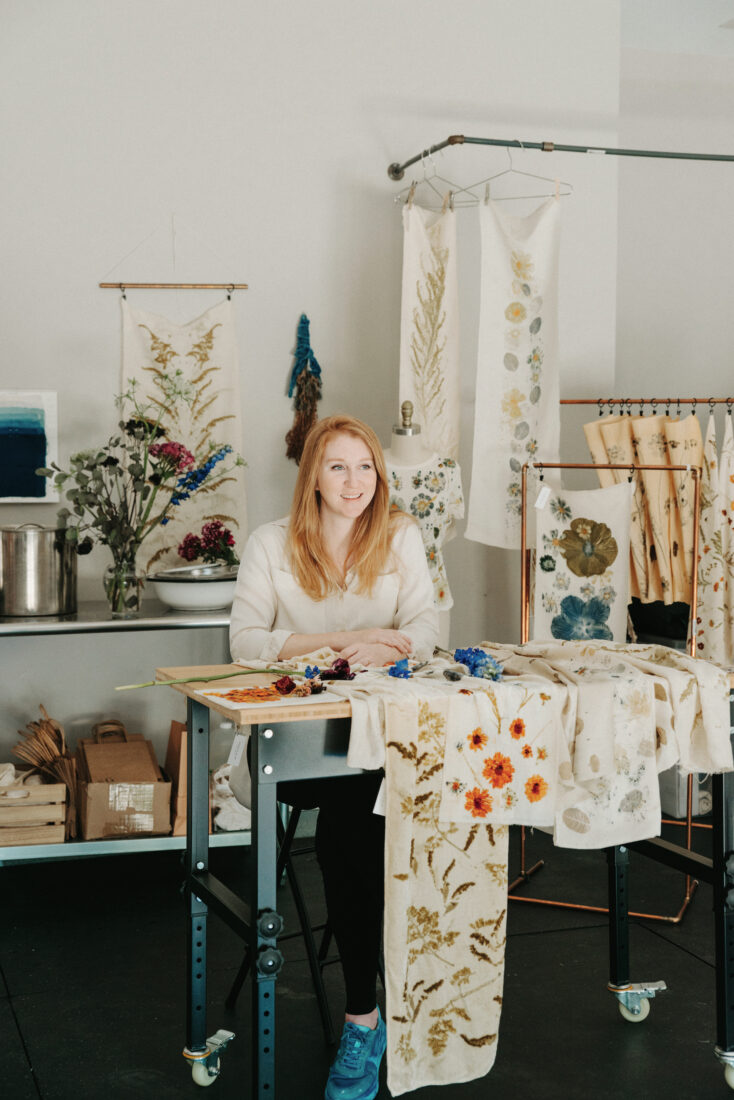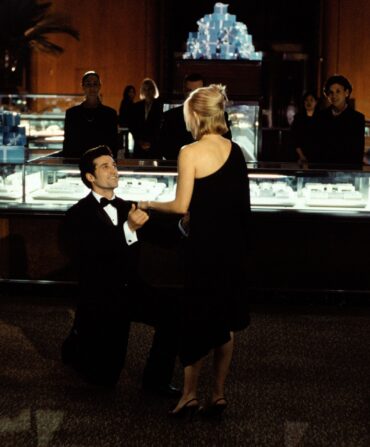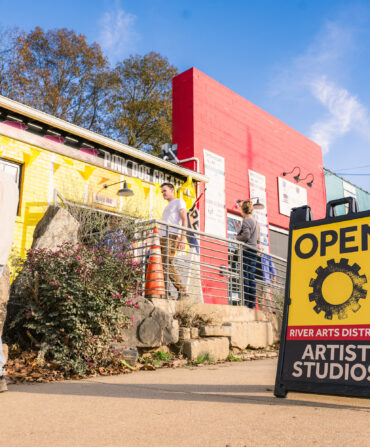Sydni Gause begins her mornings in her organic garden, pinching flowers to encourage bushiness, watering, fertilizing, and fighting off pests. Then the Panama City, Florida, artist collects mature specimens, including scabiosa and hibiscus, and heads inside to the studio with her mediums.

There, strips of creamy raw silk already tinged with blossoms of mossy greens, smoky blues, and burnt oranges hang about drying. Stepping toward the worktable, Gause begins dyeing another, submerging a square of silk in a solution of aluminum sulfate and then gently wringing it out. She lays the fabric down and arranges atop half of it purple-tinged cosmos, tiny orange tango, violet hibiscus, and rusty smoke-bush leaves, the pigments of which will shift during processing—the solution, known as a mordant, can “sadden” the color, Gause says, deepening it into a more profound tone.
Gause specializes in this type of eco-printing, using botanicals to dye textiles, which can be crafted into scarves, tapestries, or garments. The method requires natural-fiber fabric, such as raw cotton, linen, bamboo, or silk, the last of which—with its myriad weaves, textures, and sheens—makes Gause swoon. Silk’s proteins also accept natural color differently than cellulose-based cotton or linen: The hues richen, become moodier.

The artist gets her affinity for textiles from her family—her mother quilts, her grandmother knits, and her great-grandmother made hats. “I knew how to dye from working with my mom,” Gause says. “I had that language.” After completing a fine-arts degree and receiving her master’s in sculpture, though, she initially pursued academia. Then she realized she didn’t feel ready to teach. “I needed to know how to make an indigo vat, learn how to work with cochineal,” she says of the respectively blue and red dyes. Colonists historically exploited the makers of those dyes, and that loaded past led Gause to learn from Aboubakar Fofana, a West African French artist who provided an Indigenous context and spirituality to the work. That history of natural dyeing traces back to the Middle Ages and herbalism. The practice began to fade after 1856, when William Henry Perkin developed synthetic dyes, and then resurged in the 1990s thanks to the textile artist India Flint, who revived the craft and developed the eco-printing process.
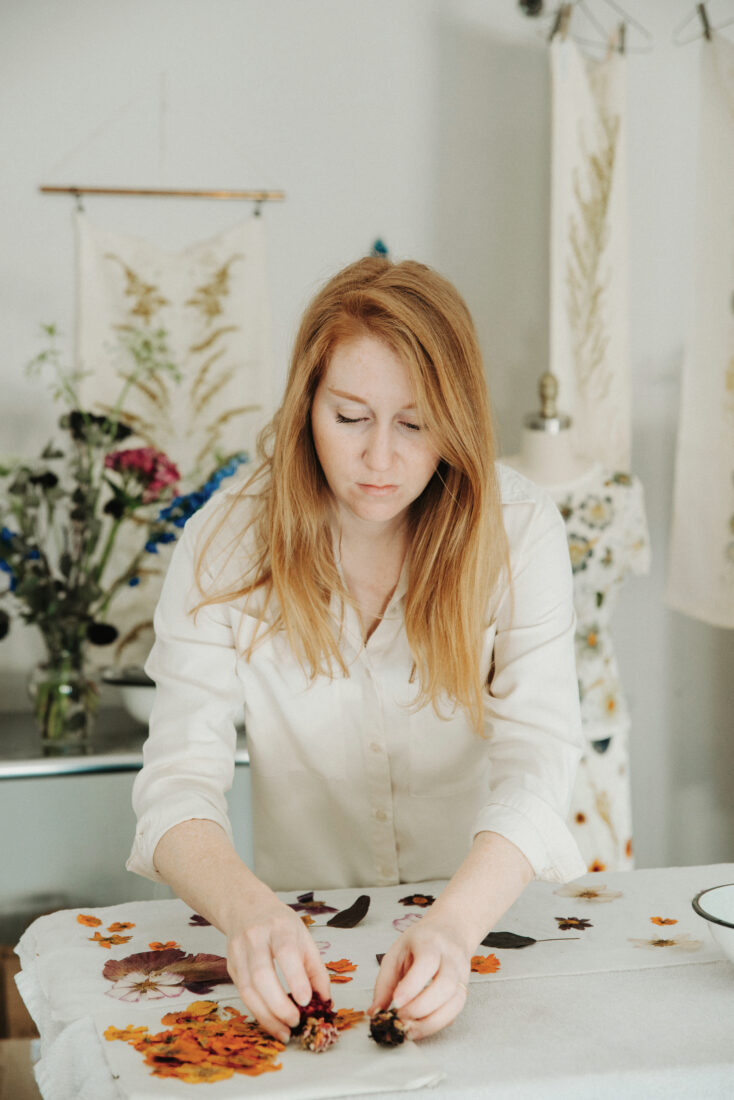
The artist gets her affinity for textiles from her family—her mother quilts, her grandmother knits, and her great-grandmother made hats. “I knew how to dye from working with my mom,” Gause says. “I had that language.” After completing a fine-arts degree and receiving her master’s in sculpture, though, she initially pursued academia. Then she realized she didn’t feel ready to teach. “I needed to know how to make an indigo vat, learn how to work with cochineal,” she says of the respectively blue and red dyes. Colonists historically exploited the makers of those dyes, and that loaded past led Gause to learn from Aboubakar Fofana, a West African French artist who provided an Indigenous context and spirituality to the work. That history of natural dyeing traces back to the Middle Ages and herbalism. The practice began to fade after 1856, when William Henry Perkin developed synthetic dyes, and then resurged in the 1990s thanks to the textile artist India Flint, who revived the craft and developed the eco-printing process.
To complete the method, after Gause sets the pattern, she spreads a layer of plastic over it and then folds the other half of the silk over that. Copper tube in hand, she rolls the layered silk over it tightly and then steams the bundle, which allows the color to transfer to the fabric. Imprinting the botanical image this way can take from six minutes to two hours, but the invisible work of prepping the fiber for the dye is more involved. “When I eco-print with a flower,” Gause explains, “it attaches itself to the mordant, producing a clear print on the silk. If I were to just roll flowers up on fabric that hadn’t been pretreated, I would just stain it.”
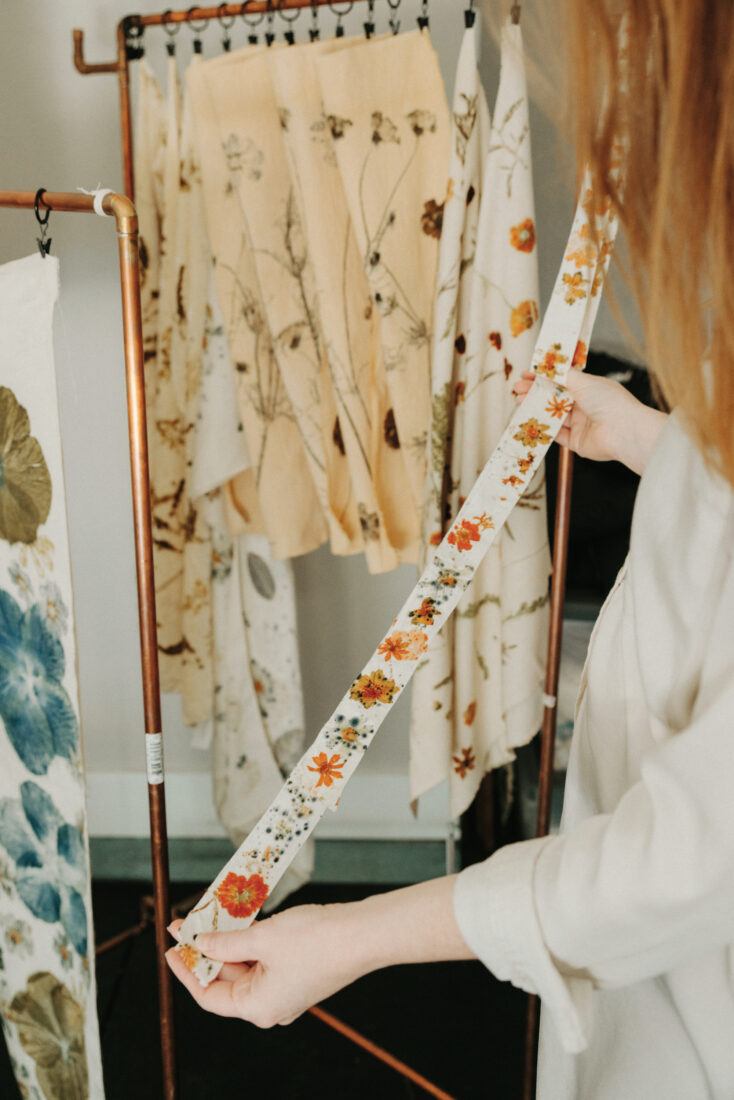
Today, Gause shares this once-lost art with others through seasonal classes at the Panama City Center for the Arts, private workshops at maker markets like Alys Beach Crafted, remote dye consultations, and an online shop of her pieces at sydnigausesilks.com. Alexis Miller, Alys Beach’s director of events, discovered Gause during a workshop. While leading the instruction, Miller recalls, Gause shared insights into which plants to use to produce various colors and patterns, her journey of connecting to the land through her art, and the history of dyeing textiles naturally. “There’s a piece of her in each scarf we created,” Miller says.
For Gause, her pieces also express a bigger story. “I hold a lot of space for the environment because I’m working directly with plants,” Gause says. “Nature needs our support to thrive. Nurturing a plant is like nurturing a child, watching it grow, giving it what it needs.” The memory of that flower, captured on a scarf or shawl that its owner will wear often, honors that delicate relationship.


